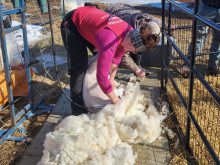Fusarium isn’t just a production problem for farmers. It is also causing nightmares for Canada’s beer makers.
The problem is premature flocculation, which Agriculture Canada plant pathologist Kelly Turkington says is being linked to the use of fusarium-infected barley in the brewing process.
In premature flocculation, the yeast settles to the bottom during brewing and fermentation is not complete.
Alcohol levels are not achieved because sugars do not convert into alcohol. The beer may have an off flavor. A bottle of beer foams and overflows when opened.
Read Also

Charges laid after cattle theft
Saskatchewan RCMP lay two charges against a man after six cattle went missing.
“Brewers want to be seen as marketing a product that is clean, healthy and enjoyable,” Turkington said at a recent Alberta Barley Commission meeting.
Bad-tasting, foamy beer can be a marketing disaster.
Millers and bakers do not want fusarium-infected wheat or barley because the fungus degrades protein. Bread dough is less elastic and does not rise properly.
As fusarium spreads east from Manitoba, maltsters and millers are looking to Alberta for clean barley.
But finding it could become difficult as the disease spreads west. It was an epidemic in Manitoba in 1993 and the crop of 2000 was equally bad.
“This year was thought to be the worst on record for this particular disease with about three-quarters of the wheat and three-quarters of the barley in Manitoba having some level of infection,” Turkington said.
Cases have already been detected in Alberta. The Canadian Grain Commission found 39 infected samples in 600 it examined from that province.
“Fusarium head blight is probably the most important and significant fungal disease that affects a cereal in Canada.”
Agriculture Canada conducted feedlot tests throughout Alberta to see if infected grain is coming into the province.
If it is found, they want to know whether it survives the bovine digest-ion process.
Five feedlots were studied. Researchers did not find fusarium graninearum, although they did detect some other fungal barley diseases.
Fusarium graninearum contains a toxin that severely affects livestock.
Hogs do not gain weight and may suffer reproductive difficulties.
Fusarium is not always easy to identify. It can be found in infected crop residue and seed.
It can shoot spores into the air in a manner similar to virulent blackleg. The spores travel for several kilometres in the wind or move from plant to plant in rain splashes. It can damage any part of the plant.

















